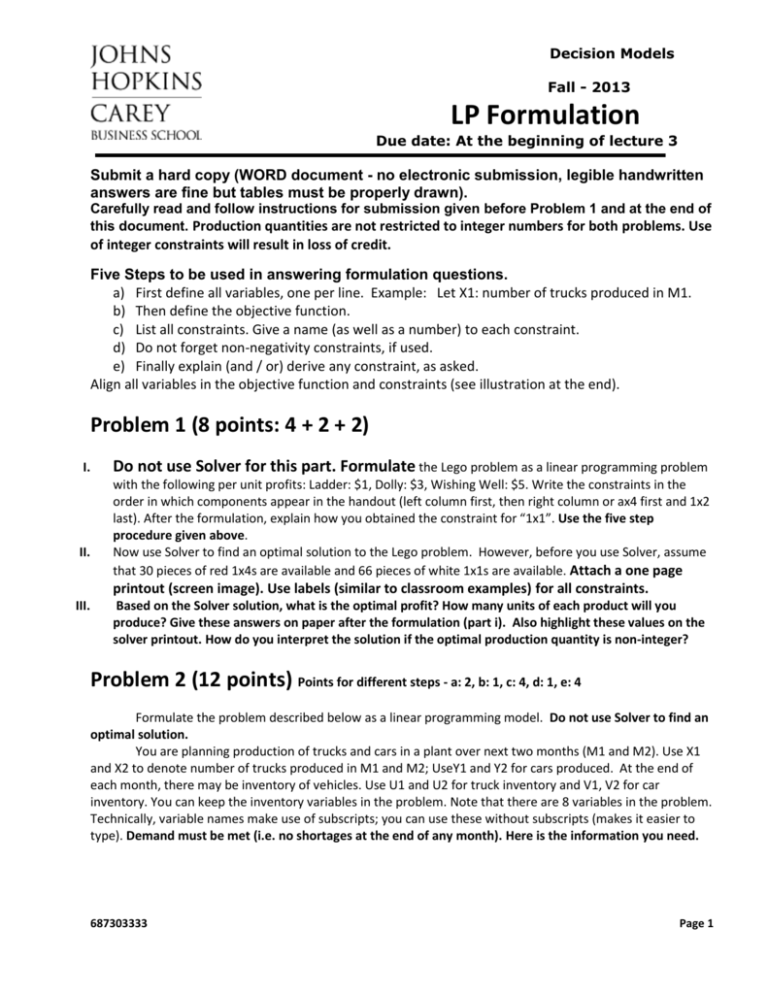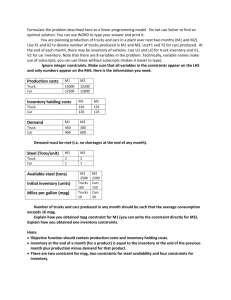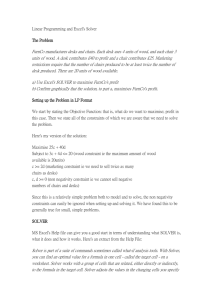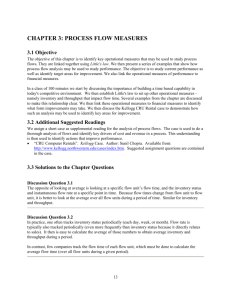LP Formulation
advertisement

Decision Models Fall - 2013 LP Formulation Due date: At the beginning of lecture 3 Submit a hard copy (WORD document - no electronic submission, legible handwritten answers are fine but tables must be properly drawn). Carefully read and follow instructions for submission given before Problem 1 and at the end of this document. Production quantities are not restricted to integer numbers for both problems. Use of integer constraints will result in loss of credit. Five Steps to be used in answering formulation questions. a) First define all variables, one per line. Example: Let X1: number of trucks produced in M1. b) Then define the objective function. c) List all constraints. Give a name (as well as a number) to each constraint. d) Do not forget non-negativity constraints, if used. e) Finally explain (and / or) derive any constraint, as asked. Align all variables in the objective function and constraints (see illustration at the end). Problem 1 (8 points: 4 + 2 + 2) I. II. Do not use Solver for this part. Formulate the Lego problem as a linear programming problem with the following per unit profits: Ladder: $1, Dolly: $3, Wishing Well: $5. Write the constraints in the order in which components appear in the handout (left column first, then right column or ax4 first and 1x2 last). After the formulation, explain how you obtained the constraint for “1x1”. Use the five step procedure given above. Now use Solver to find an optimal solution to the Lego problem. However, before you use Solver, assume that 30 pieces of red 1x4s are available and 66 pieces of white 1x1s are available. Attach a one page printout (screen image). Use labels (similar to classroom examples) for all constraints. III. Based on the Solver solution, what is the optimal profit? How many units of each product will you produce? Give these answers on paper after the formulation (part i). Also highlight these values on the solver printout. How do you interpret the solution if the optimal production quantity is non-integer? Problem 2 (12 points) Points for different steps - a: 2, b: 1, c: 4, d: 1, e: 4 Formulate the problem described below as a linear programming model. Do not use Solver to find an optimal solution. You are planning production of trucks and cars in a plant over next two months (M1 and M2). Use X1 and X2 to denote number of trucks produced in M1 and M2; UseY1 and Y2 for cars produced. At the end of each month, there may be inventory of vehicles. Use U1 and U2 for truck inventory and V1, V2 for car inventory. You can keep the inventory variables in the problem. Note that there are 8 variables in the problem. Technically, variable names make use of subscripts; you can use these without subscripts (makes it easier to type). Demand must be met (i.e. no shortages at the end of any month). Here is the information you need. 687303333 Page 1 Inventory holding costs M1 M2 Production costs M1 M2 Steel needed (Tons/unit) M1 M2 Truck Car 150 120 155 125 Truck Car 15000 12500 15200 12600 Truck Car 1.8 1.1 1.8 1.1 M1: 2500 M2: 2200 Available steel (tons) Initial inventory (units) Trucks: 100 Cars: 150 Miles per gallon (mpg) Trucks: 20 Cars: 30 Demand M1 M2 Truck 450 300 Car 400 550 Number of trucks and cars produced in any month should be such that the average consumption must be at least 26 mpg. In step (e), explain how you obtained mpg constraint for M1 and also explain how you obtained one inventory constraints. There is no need to explain other constraints, you can write the constraint directly. Hints: You can use only production quantities as decision variables or you can include inventory quantities to the list of variables. The latter may be easier. In either case, the objective function should contain production costs and inventory holding costs. There are two constraints for mpg, two constraints for steel availability and four constraints for inventory. Sample illustration: Part (c) Problem is first entered in to Excel (see below the screen shot of three constraints) Then copy and paste it into WORD. 1) Material availability 2) Labor hours 3) Production restriction 0.75x1 + 2.00x1 + x1 - 1.2x2 + x2 2x2 0.75x3 + + 1.0x4 3.0x4 ≤ ≤ ≥ 400 480 0 Illustration of step (e) Explanation / derivation of constraint 3 (Production restriction): You must produce at least twice as many units on product 1 compared to product 2. So, (x1 / x2) ≥ 2. This means x1 ≥ (2x2), or x1 – 2x2 ≥ 0. 687303333 Page 2











